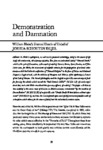Demonstration and Damnation: William Blake's Eternal Death of Unbelief
| dc.contributor.author | Schouten de Jel, Joshua | |
| dc.contributor.other | Faculty of Arts & Humanities | en_US |
| dc.date.accessioned | 2021-02-20T10:07:14Z | |
| dc.date.available | 2021-02-20T10:07:14Z | |
| dc.date.issued | 2018 | |
| dc.identifier.uri | http://hdl.handle.net/10026.1/16899 | |
| dc.description.abstract |
In Blake’s mythopoeia, as well as his personal eschatology, belief is the source of life itself; all creative acts, all visionary episodes, stem from an individual’s belief. “Eternal Death,” which is the cycle of Generation, is the result of unbelief. Francis Bacon, Isaac Newton, and John Locke were, for Blake, the triumvirate of culpable votaries for the propagation of rational reductionism which had led to the reification of “Natural Religion” in the form of Deism and Rational Dissent in England and, with the addition of Rousseau and Voltaire, of the apotheosis in France of the Cult of Reason. The French philosophes and the English empiricists were not only at fault for forming the wheels which turned the “dark Satanic Mills?” (M 514 1.8) of man’s cognizance but, and what Blake considered their primary offence, of unbelief. This paper will discuss how unbelief is the main cause of division in Blake’s universe, accentuated “by the cruelties of Demonstration” (M 578 29.36) of empiricists who “Doubt Doubt & dont believe without experiment” (NB 609 5–9), and how the Limits placed upon man’s fall(s) act as one possible mode of redemption which allows for the return of belief and the individual’s creative vision. | en_US |
| dc.language.iso | en | |
| dc.publisher | University of Plymouth | en |
| dc.relation.uri | https://d1f0cda6-787d-4f41-ae20-19e584ee850f.filesusr.com/ugd/8918a7_c78c99b816c54958a66b00ba7059b4d8.pdf | en_US |
| dc.subject | William Blake | en_US |
| dc.subject | Eternal Death | en_US |
| dc.subject | Unbelief | en_US |
| dc.title | Demonstration and Damnation: William Blake's Eternal Death of Unbelief | en_US |
| dc.type | Article | en_US |


